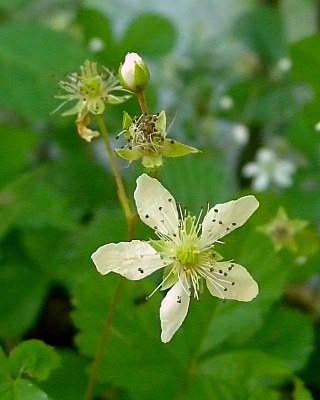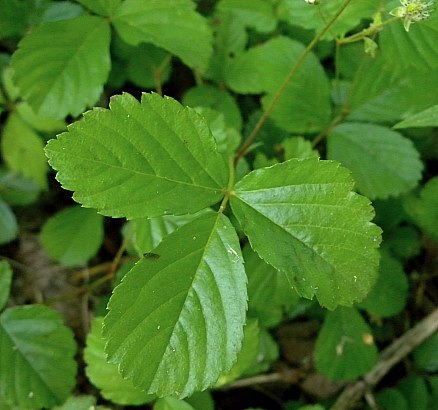
Occasionally, small cymes of 3-6 flowers are produced from axils of the leaves on peduncles up to 6" long. The peduncles are light green to reddish green and sparsely to moderately covered with small bristles or hairs. Each flower is ½-¾" across, consisting of 5 white petals, 5 light green sepals that are united at the base, a ring of numerous stamens, and a compound pistil at its center that is light green. The petals are oblong-elliptic in shape, while the sepals are ovate and softly hairy. The blooming period occurs during early to mid-summer for about 3 weeks. Fertile flowers are replaced by compound drupes that are ¼-½" in length at maturity. Immature drupes are light green or white, becoming red during an intermediate stage, and finally dark purple or black when they are ripe. Each drupe consists of a cluster of small drupelets; each fleshy druplet contains a single seed. Usually, the flavor of mature drupes is sour. The root system is woody and branching. Sometimes the tips of trailing stems develop rootlets on moist ground, enabling this vine to spread vegetatively. The leaves are semi-evergreen and often become reddish during the fall or winter.
Cultivation: The preference is dappled sunlight, wet to moist conditions, and an acidic soil containing sand or peat.
Range & Habitat: The native Swamp Dewberry (Rubus hispidus) is occasional in northeast Illinois and either rare or absent elsewhere in the state. Habitats include swamps, moist sandy woodlands, moist sandy thickets, moist sand prairies and sandy shrub prairies, edges of marshes, and bogs. This vine is found in both degraded and higher quality habitats, favoring areas that have been burned over by fire during periods of drought.
Faunal Associations: The flowers of Swamp Dewberry (Rubus hispidus) are visited primarily by bees, including little carpenter bees (Ceratina spp.), mason bees (Hoplitis spp., Osmia spp.), and Halictid bees (Grundel et al., 2011). Other insects that may visit the flowers include Syrphid flies, bee flies (Bombyliidae), small butterflies, and skippers. Both nectar and pollen are available as floral rewards to such visitors. The remaining information about floral-faunal relationship applies primarily to Rubus spp. in general, which consist of blackberries, raspberries, and dewberries. Many insects feed on the leaves, stems, fruit, plant juices, and other parts of these woody plants. These species include cane-boring beetles, leaf beetles, stink bugs, aphids, leafhoppers, treehoppers, katydids, walkingsticks, thrips, the larvae of sawflies, and the larvae of many moths. The larvae of a butterfly, Striped Hairstreak (Satyrium liparops strigosum), feeds on these plants. The Insect Table provides a more detailed list of these insect feeders. Vertebrate animals also use Rubus spp. as sources of food, particularly their fruits. The fruits of dewberries are sometimes eaten by turtles, including the Wood Turtle (Clemmys insculpta ), Eastern Box Turtle (Terrapene carolina), Ornate Box Turtle (Terrapene ornata), and Eastern Mud Turtle (Kinosternum subrubrum); see Lagler (1943) and Ernst et al. (1994). Many mammals also feed on the fruits of dewberries and other Rubus spp., including the Black Bear, Gray Fox, Red Fox, Raccoon, Opossum, Eastern Chipmunk, Least Chipmunk, Gray Squirrel, Fox Squirrel, Woodland Jumping Mouse, Meadow Jumping Mouse, White-Footed Mouse, and Woodland Deer Mouse (Beeman & Pelton, 1980; Martin et al, 1951/1961; Hamilton, 1941; Whitaker & Mumford, 1970). In wetland areas, muskrats feed on the roots to a minor extent, while the American Moose, Elk, White-Tailed Deer, and Cottontail Rabbit feed on the foliage and woody stems in a wider range of habitats (Hamerstrom & Blake, 1939; Martin et al., 1951/1961; Schneider et al., 2006). The fruits of Rubus spp. are also eaten by upland gamebirds and many songbirds (see Bird Table). These various animals help to disperse the seeds of fruits into new areas. The canes and foliage of these plants, along with their tendency to form dense thickets, also provide nesting habitat for many birds and protective cover for various kinds of wildlife.
Photographic Location: A sandy swamp at the Indiana Dunes State Park in NW Indiana.

Comments: While most blackberries and raspberries produce arching canes up to 6' high, dewberries produce trailing stems that creep along the ground. Compared to the upland species, Rubus frondosus (Common Dewberry), Swamp Dewberry has leaflets with tips that are more blunt and its stems are bristly, rather than prickly. The flowers of Swamp Dewberry are also smaller in size (½-¾" in across) than those of Common Dewberry (¾-1" across). Another species, Rubus pubescens (Dwarf Raspberry), also produces trailing stems like a dewberry and it is found in habitats that are similar to those of Swamp Raspberry. Dwarf Raspberry usually has leaflets with more pointed tips than those of Swamp Dewberry, and its stems have soft hairs, rather than sharp bristles or prickles. Dwarf Raspberry usually produces its flowers individually, rather than in small corymbs, and its mature fruits are red, rather than dark purple or black. Another dewberry, Rubus trivialis (Southern Dewberry), occurs in southern Illinois. This latter species differs from Swamp Dewberry by having stems with both prickles and gland-tipped hairs. Its non-flowering stems produce leaves with 5 leaflets, rather than 3 leaflets, and its flowers are produced individually, rather than in small corymbs.